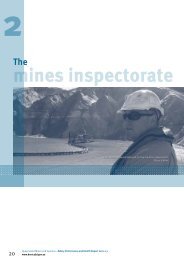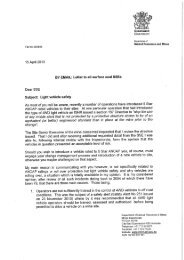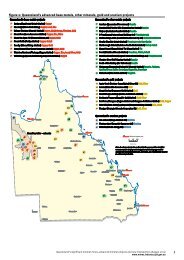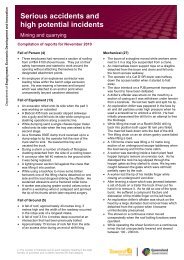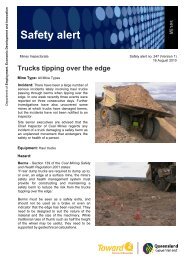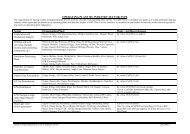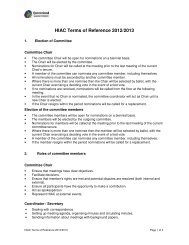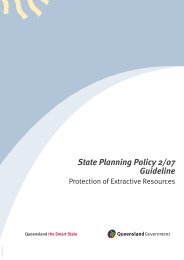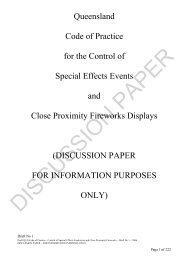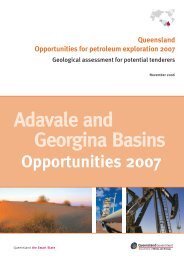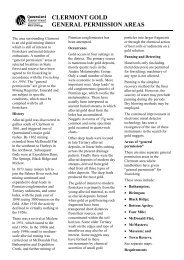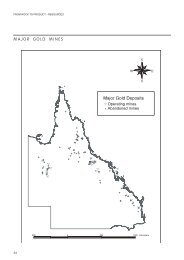Code of Practice for coal seam gas well head emissions detection ...
Code of Practice for coal seam gas well head emissions detection ...
Code of Practice for coal seam gas well head emissions detection ...
Create successful ePaper yourself
Turn your PDF publications into a flip-book with our unique Google optimized e-Paper software.
. For leaks identified on <strong>well</strong> equipment - higher order controls, such as containment by<br />
repair, must be implemented wherever possible.<br />
c. For leaks identified on <strong>well</strong> casings or adjacent to the <strong>well</strong> casing (where a work over rig<br />
is necessary to affect repair) - determine whether the leak requires immediate repair, or<br />
whether the risk can be adequately managed via other control measures until a work over<br />
<strong>of</strong> the <strong>well</strong> is scheduled <strong>for</strong> normal operational reasons. The risk assessment to<br />
determine the above must consider the location <strong>of</strong> the <strong>well</strong>, likely access to the <strong>well</strong> from<br />
landholders or the general public, and landholder/community concerns in relation to the<br />
leak.<br />
7. Provide a written close-out report to the P&G Inspectorate within 96 hours <strong>of</strong> <strong>detection</strong> <strong>of</strong> the<br />
leak, specifying the date <strong>of</strong> identification, nature and level <strong>of</strong> leak, location and name <strong>of</strong> the<br />
<strong>well</strong>, the rectification actions taken or proposed and the current status <strong>of</strong> the leak (e.g.<br />
isolated, repaired, etc).<br />
8. If remediation is delayed <strong>for</strong> any reason then a final close out report must be provided when all<br />
work is completed.<br />
The P&G Inspectorate may upon review <strong>of</strong> the report and risk assessment require further<br />
in<strong>for</strong>mation or action in accordance with its en<strong>for</strong>cement policy and regulatory role.<br />
Extensions<br />
If a risk assessment determines that the risks <strong>of</strong> immediately repairing a leak exceed the risk<br />
posed by the leak, this can be considered as grounds <strong>for</strong> extension <strong>of</strong> the 48 hour remediation<br />
period, provided that other measures to mitigate the risk are undertaken (e.g. ensuring no ignition<br />
sources or personnel are permitted in the exclusion zone). The P&G Inspectorate must be notified<br />
(be<strong>for</strong>e the expiry <strong>of</strong> the 48 hour remediation period) <strong>of</strong> the proposed delay.<br />
Internally reportable leaks<br />
In the event that a CSG operator detects an “Internally Reportable Well Head Leak” (see<br />
definitions) at any CSG <strong>well</strong> site facility, the CSG operator must promptly respond in accordance<br />
with the actions specified in the relevant CSG operator’s ‘Leak Management Plan’ and other safety<br />
management plan requirements.<br />
On an annual basis (via the annual safety report), a summary <strong>of</strong> all <strong>well</strong> <strong>head</strong> reportable leaks and<br />
internally reportable leaks must be provided to the P&G Inspectorate.<br />
Protection <strong>of</strong> CSG <strong>well</strong> site facilities<br />
Appropriate signage, barriers and/or security fencing to isolate CSG <strong>well</strong> site facilities must be in<br />
place <strong>for</strong> all <strong>well</strong> site facilities as determined by the CSG operators risk assessment and<br />
management. The risk assessment must be consistent with AS/NZS:60079 Explosive<br />
atmospheres Part 10.1:2009 and will consider:<br />
1. Risks posed by third parties and the general public based on proximity <strong>of</strong> the CSG <strong>well</strong> site<br />
facilities the ownership <strong>of</strong> land, and the accessibility <strong>of</strong> the CSG <strong>well</strong> site facilities to the<br />
general public; and<br />
2. The magnitude <strong>of</strong> the risk posed by the CSG <strong>well</strong> site facilities, which may be dependent on<br />
the type <strong>of</strong> <strong>well</strong> completion the equipment/facilities installed at these sites and the pressure,<br />
flow rate and composition <strong>of</strong> the <strong>gas</strong> contained by the facilities.<br />
CSG operators must ensure that all required fencing and signage is in place after the <strong>well</strong> is drilled<br />
and also after surface equipment is installed.<br />
<strong>Code</strong> <strong>of</strong> <strong>Practice</strong> <strong>for</strong> CSG <strong>well</strong> <strong>head</strong> <strong>emissions</strong>, <strong>detection</strong> and reporting - Version 2 June 2011 10



